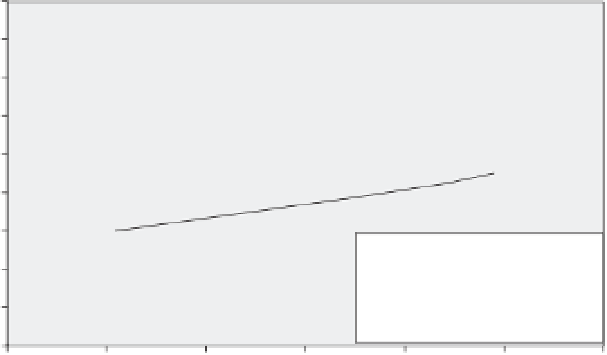Agriculture Reference
In-Depth Information
centimetre (provided by the inter-granular
pores) - allow an excellent circulation of water
vapour.
These characteristics vary with the pro-
portion of binder. Figure 17.11 illustrates the
variation in thermal conductivity λ of hemp as
a function of its density and therefore as a
function of the proportion of binder. Even for
binding agents that are relatively porous and
therefore good insulators, an increase in the
amount of binder will increase conductivity:
λ between 0.06 and 0.18 W/m °C for dry con-
crete with a density ranging between 200 and
800 kg/m
3
.
Finally, as we have seen already for wool,
the porosity of the material renders it sensitive
to humidity exchange with ambient air. This
phenomenon is far from insignificant, because
the high concentration of water in hemp
cement (density of cement 450 kg/m
3
) sub-
jected to a hygrometry of 75% RH (relative
humidity) will see thermal conductivity increase
by 30% (Fig. 17.11).
Sound waves move through the air as a
result of small oscillations of variable frequency.
For humans, the range of audible waves varies
between 100 and 6400 Hz. When a moving
sound wave encounters a wall, the energy car-
ried is broken up into:
•
A part that is transmitted through the wall.
This is particularly significant where the
wall is light and permeable. In the absence
of the wall, the sound can travel over long
distances.
A reflected part, which is greatest for
•
heavy walls that are impermeable to air.
A last part made up of energy that is
•
absorbed by the wall. The mechanical
wave is pulsed into the wall's porous inter-
ior. In doing so, it rubs along within the
pores and this friction slows it down.
It should be emphasized that the acoustic com-
fort of a room is related directly to the capacity
of the building materials to absorb noises pro-
duced within the room. Rooms that are insu-
lated from external noise tend to have thick
walls and this often results in very loud rooms,
as interior noise will reverberate for some time
before being absorbed.
The material's properties are measured
with the help of a coefficient of acoustic absorp-
tion,
Acoustic behaviour
From an acoustic point of view, the low den-
sity of hemp cement does not allow it to insu-
late in bulk. Once again, though, it is the
cement's reservoir of pores left exposed on
the surface that allows it to absorb the energy
of sound waves.
. This figure represents the percentage
of energy absorbed relative to the amount
α
0.18
0.16
WALL
0.14
0.12
ROOF
TILE
0.1
0.08
0.06
Theoretical (HR=0%)
Measures 1(40% HR)
Measures 2 (40% HR)
0.04
0.02
0
150
200
250
300
350
400
450
Density (kg.m
-3
)
Fig. 17.11.
Changes in the thermal conductivity of hemp cement as a function of the proportion of binder
used and the relative ambient humidity.




















